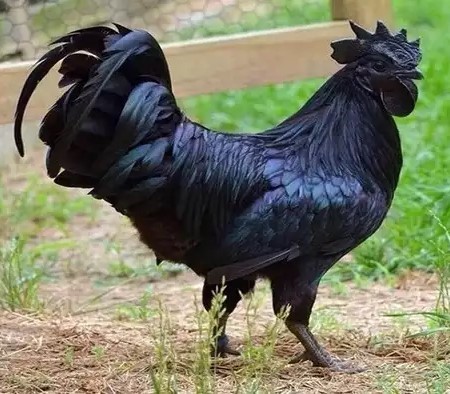BACKYARD POULTRY FARMING
Anupam Brahma1*, Saurabh Karunamay2, Demian C. Johnson3, Rahul G. Kadam4, Suvaneeth. P5
1*Assistant Professor, Department of Veterinary Parasitology, FVAS, I.Ag.Sc., RGSC, Banaras Hindu University, Mirzapur, U.P.:- 231307.
2Assistant Professor, Department of Livestock Products Technology, FVAS, I.Ag.Sc., RGSC, Banaras Hindu University, Mirzapur, U.P.:- 231307.
3Assistant Professor, Department of Veterinary Extension, FVAS, I.Ag.Sc., RGSC, Banaras Hindu University, Mirzapur, U.P.:- 231307.
4Assistant Professor, Unit of Teaching Veterinary Clinical complex (Veterinary Pathology), FVAS, I.Ag.Sc., RGSC, Banaras Hindu University, Mirzapur, U.P.:- 231307
5Assistant Professor, Department of Veterinary Pathology, FVAS, I.Ag.Sc., RGSC, Banaras Hindu University, Mirzapur, U.P.:- 231307.
*Corresponding author-anupam619@yahoo.com
INTRODUCTION
Poultry refers to the domesticated birds (Duck, Hen, Quail, Turkey etc.)reared by humans for egg, meat and feather. According to the 20th Livestock Census report, the total poultry birds in India was851.8 million and among them 250 million (near about 30%) are considered as ‘backyard poultry’ and are majorly reared by the small farmers in the rural areas of Andhra Pradesh, Karnataka, Tamil Nadu, Telangana, Maharashtra, West Bengal, Kerala and Assam.
Backyard poultry farming is a type of age old farming system adopted at village level. The native and resilient birds are reared in the free space of rural households and as there is involvement of low cost in the input, the majority of the feed intake in the birds come fromfreely available variety of small flora and fauna present in the backyard space. This not only proves to be economic in terms of farming by small and marginal farmers but also provides attractive opportunities for many youths in self-employment venture with guaranteed and profitable returns.
Besides, being a dynamic revenue generating source the backyard poultry farming also becomes beneficial in enhancing the soil fertility, thus eliminating the requirement for additional commercial manure from outside. A group of 14-15 chickens producing 1-1.2 kg of manure per day in this regard, has the potential to become an essential component of integrated farming also.Currently there is an ever increasing demand for green food products (or the food which is free from chemical residues) across the world, and continuing alongside this ongoing trend, the recent rise in purchase of meat from backyard poultry among health conscious non vegetarians have fetched high pricescompared to those from intensive poultry farming. As the birds are reared and raised in stress free environment the quality of eggs often is better and most of the brown shelled eggs from the backyard poultry get sold at double the prices in the local market thus egg sale from backyard poultry has become more encouraging to the farmers in terms of good profitable returns.
Many research studies in poultry sector have proved that birds reared under free range conditions produce eggs and providemeat of low cholesterol concentrationcompared to those produced under intensive poultry farming, this therefore having almost neutral implications on human health and thus, consequently can also help to meet protein requirement and eliminate malnutrition in susceptible population that includepregnant ladies, aged groups and children.
This farming system can be started as an unit consisting ofa very small size with low initial capital investment which can then be increased with economic returns and a part of those can also be utilized in other farming ventures such as the integrated farming system.Major expenditure in any farming system is on nutrition. In backyard poultry farming, birds can be reared with use of agricultural by-products, farm and kitchen waste etc. So, low feed cost is involved which lead to maximum profit.
The backyard poultry farming assumes its profitable and viable significance owing to the utilization of disease resistant desi or native birds having better adaptability to extreme climatic conditions thus, making them beneficial even when raised on poor management and housing arrangements. Since their overall management is somewhat low, there is zero necessity of labourers and instead can comfortably be attended by the family members specially women in the rural households.Currently both the egg and meat production from the poultry sector in India has become robust and highly commercial and therefore India ranks 4th in the world and on the other hand 5th in rank with regards to broiler production.
In this hand book, chickens hasbeen used as a model for illustration and example for backyard poultry farming.
What should be the prerequisites for an ideal backyard poultry farming system ?
When choosing a poultry bird for backyard farming, it is very much essential to look for desirable traits either in the parent stocks or in the pedigree records and with the best available information there should be a final assessment before procuring the desired breed. The following are some of the essential points to be kept in mind while going for choosing a poultry bird breed:
- It is always advisable to choose poultry that are bright, attentive with high alertness, and playfully active. They should also possess smooth, glossy, and soft feathers that are free of debris or droppings. Poultry that seem dull and sluggish, with depressed activity, or look dirty may be ill.
- Some of the traits that can be easily assessed are : shank colur, comb pattern, age at first egg production, annual egg production, dressing percentage of meat etc.
- Local help of veterinarian should be taken to manage and stream line the poultry unit for egg and meat production separately with standard protocols.
Popular native poultry breeds in India
India is home to some of the most productive and popular desi or native breeds of chicken. These native chicken breeds since long time back have not only been reported to be of high source of protein and essential nutrients but also of possessingsome remarkably beneficial medicinal properties for some of the common ailments in humans such as low blood pressure, diabetes etc.
Some Popular breeds of chicken for backyard poultry farming in Indiaalong with few performance indicators:
| Sl. No |
Poultry Bird |
Body Weight (gms.) | Age (Days) at first egg production | Egg weight in gms.
(28 weeks) |
Egg production 280 days |
Dressing percentage % |
|
| 0 week | 6 weeks | ||||||
| 1 | Ankleshwar | 28-30 | 450-550 | 178-182 | 35-40 | 74-75 | 62.44 |
| 2. | Aseel | 28-30 | 245-300 | 186-190 | 34-38 | 90-95 | 75.00 |
| 3. | Daothigir | 25-32 | 280-320 | 180-188 | 42-48 | 60-70 | 74.00 |
| 4. | Giriraja | 40-45 | 850-900 | 164-168 | 50-54 | 70-73 | 75.00 |
| 5. | Gramapriya | 35-38 | 400-500 | 150-154 | 52 -56 | 70-74 | 67.70 |
| 6. | Kadaknath | 34-40 | 345-400 | 184-188 | 42-46 | 98-102 | 72.00 |
| 7. | Kamrupa | 45-55 | 400-500 | 180-200 | 44-50 | 118-125 | 70.00 |
| 8. | Kuroiler | 35-45 | 450-550 | 158-165 | 50-58 | 120-140 | 65.00 |
| 9. | Miri | 26-28 | 450-520 | 208-214 | 40-42 | 60-62 | 70.00 |
| 10. | Punjab Brown | 24-28 | 400-480 | 180-185 | 46-48 | 60-80 | 70.00 |
| 11. | Vanraja | 35-40 | 700-800 | 174-180 | 42-46 | 55-65 | 72.00 |
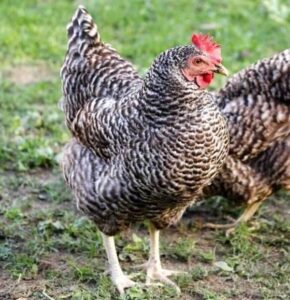
ANKLESWAR |
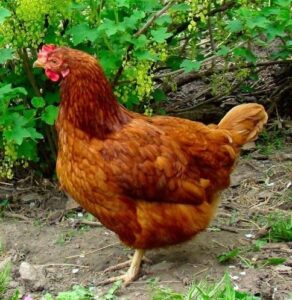
GIRI RAJA |
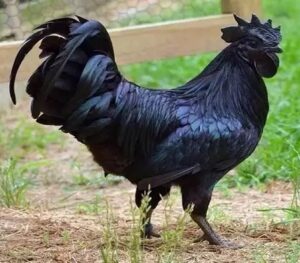
KADAKNATH |
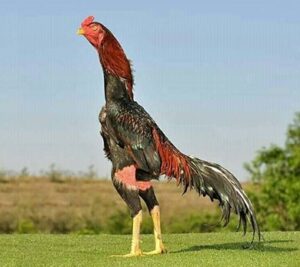
ASEEL |
Phases of Backyard poutry farming
There are two important phases of backyard poultry farming : a) Nursery rearing and b) Free-range rearing.
Nursery rearing:-Nursery in the context of animal rearing means a place where young animals grow or are cared for. This phase of rearing in backyard poultry farmingis based upon intensive poultry rearing and typically involves rearing the chicks upto 30-42 days while providing essential feed, hygienic water, adequate comfortable temperature and clean and safe environment.
Free-range rearing:- This phase involves promoting free range movement of the mature birds into the open space or the backyard. However, it has to be done by the farmer during suitable weather or season. In the free range system the birds meet their daily essential nutrient requirement from the grass, fodders and insects apart fromminimal extra supplementary feed.
Care and Management of Chicks:-
It is advisable to have some requirements fulfilled before the arrival of fresh chicks or new poultry unit, so that care and management of the poultry unit can be done with ease without putting stress to the birds. Some of the care and managemental steps that can be followed in this regard are:
- Shed can be built with locally available materials. A floor space of 6-8 sq.inch should be provided for each chick. The thickness of litter material (ground nut husk or paddy husk or saw dust) should be 2-3 inches, and should be spread in an uniform manner. The litter should be changed every 4-6 days to prevent litter borne infections. The drinkers and feeders in the shed should be arranged alternatively.
- To have a uniform and healthy stock of birds it is very important to procure improved varieties of day old chick from reputed hatcheries and sources . This will save unnecessary wastage of time and money. The farmer should also develop a self-assessment criteria for opting the improved varieties of chicks that suits his/her purpose.
- The Day old chicks when brought should be housed for brooding which has been warmed to 95℃. This can be achieved by placing 20 to 30 chicks below one 40 watt bulb. A chick guard should be used to prevent birds from unnecessary wandering.Alternatively when there is no electricity Charcoal Choolah (Bukhari) can be used. Glucose and anti stress medicine should be provided in the drinker.
- Brooding should be done for 2-3 weeks and at the end of 3 weeks they can be slowly allowed to graze outside. To ensure that birds eat balanced pickings, allow them to scavenge in the morning and continue until late in the evening around spilled grains, greens and insects.
- Once the chicks attain 4-5 months of age the male and female should be segregated and the unwanted males can be either sold or kept for meat purpose.
- Provide plenty of clean drinking water and there should be regular cleaning of water and feed troughs.
- Locally prepared feed can be provided to the growing chicks rich in vitamins and minerals for enhanced performance. The basic nutritious feed can be prepared by using the following local ingredients :
- Maize/Bajra/Jowar/ Ragi – 50 parts
- Rice Bran/Wheat Bran/Deoiled rice bran – 20 parts
- Soyabean meal/ Ground nut meal/ Sunflower meal – 28 parts
- Vitamin and Mineral mixture – 2 parts
Disease Control in backyard poultry
The prevalent disease in rural areas affecting chicken are New Castle (Ranikhet disease), parasitic and infectious diseases. These diseases may either get introduced into the shed due to poor biosafety measures or high negligence in basic hygiene. Some of the necessary steps that can be taken to control and manage disease in backyard poultry farming are:-
- Use of Dewormers: Chronic parasitism in poultry birds not only affects their overall health but also gravely weakens their immune system. Deworming properly and at regular intervals thus not only ensures the elimination of harmful parasites, but also indirectly aids in maintenance of an active immune system and minimizing chances of other infectious diseases.
(Ex- Piperazineliquid:- 50ml/100 birds, Panacur suspension:- 6 ml/100 birds).
- Use of antimicrobial and antimycoplasma drugs: Although the native breeds used in the backyard poultry rearing are themselves resilient and resistant to many infectious diseases however, during introduction of new birds without isolation for few days can be a triggering factor for spread of some diseases. Judicious use of antimicrobials and antimycoplasmal drugs can manage this situation effectively.
(Ex- Amoxycillin 50%, Cephalexin 7.5%, Tylosin 50%).
- Use of anticoccidials: Perhaps the most important litter borne infectiousdisease is the caecal coccidiosis that can cause mortality upto 55 % in a flock. In an affected flock, the first noticeable symptoms of caecalcoccidiosissuch as: drooping, ceasing of consumption and huddlingappear at about 72 hours, followed by blood in droppings at 96 hours.Therefore, it becomes of utmost importance to regularly do raking of litter (at least 2 times a day)to prevent sporulation of oocysts, thereby minimizing chances of infection. During rainy season lime powder can be used to dry the litter and to render the oocysts ineffective. Alternativelyanticoccidial drugs can be used in a scheduled manner or more specifically by practicing shuttle programme to both effectively control coccidial oocyst and prevent drug resistance.
(Ex- lonophores, sulphonamides, and quinolones as feed additives).
- Immunization :Immunizationby vaccination is another essential step to prevent outbreak of some viral diseases in the flock. However, few precautionary measures should be kept in mind while vaccinating the birds.
- All the birds of a given unitshould be vaccinated on the same day.
- Vaccination should be started early just before sunrise.
- Unnecessary rough handling of birds should be avoided.
- Cold chain or maintenance of cold temperature for storing vaccines should not be compromised at any cost.
- Use of antistress drugs (Ex. Vimeral) should be given post vaccination.
An effective vaccination schedule for backyard poultry birds consists of the following vaccines:
| Age | Name of the Vaccine | Strain | Dose | Route |
| In the Hatchery | ||||
| 1st Day | Marek’s Disease | HVT | 0.20 ml | S/C |
| In the Nursery | ||||
| 05th Day | New Castle Disease | Lasota | One Drop | Eye |
| 14th Day | Infectious Bursal Disease | Georgia | One Drop | Oral |
| 21st Day | Pox | Fowl pox | 0.20 ml | IM/SC injection |
| 28th Day | New Castle Disease | Lasota | One Drop | Eye |
| In the Field | ||||
| 9th Week | New Castle Disease* | R2B | 0.50 ml | SC injection |
| 12th Week | Pox* | Fowl Pox | 0.20 ml | SC injection |
*Repeat these two vaccines at every 6 months interval.
- Biosafety measures:-Biosafety is the prevention of large-scale loss of biological integrity so, it should always be borne in mind that poultry birds are carriers of some infectious diseases to men and on the other hand they can also inadvertently get exposed to pathogens introduced by humans, therefore just like any other farming system it is strictly advisable to practice a dedicated biosafety measure protocol to ensure effective management of diseases and overall well being of the birds. Some of the necessary biosafety measures that can be undertaken are:
- The poultry or waterfowl shouldn’t get access to home for any reason, including areas where food or drink is prepared, served,or stored, such as kitchens or outdoor cooking facilities.
- There should be provision for safe, sturdy environment outdoors, with proper fencing or enclosures in the backyard space. The water storage facility should be easily cleanable alongside the practice of regular cleaning of feed and water troughs.
- A dedicated pair of shoes should be kept for attending the backyard poultry units.
- A diluted bleach solution should be used to disinfect the materials exposed to poultry units and related stuffs.
- The poultry cages can be cleaned by bottled dish soap and a commercial disinfectant made for this purpose.
- Eggs are potent source of Salmonella organisms and thus are infectious to humans with low immunity such as young children and aged people. It is therefore necessary to wash your hands with soap and water right after handling eggs, chickens, or anything in their environment.
- The shed should be always kept clean and tidy to facilitate circulation of fresh air.
Conclusion: Backyard poultry farming with its potential to uplift the socio economic status of rural and marginal farmers has also attracted the young generation by providing them high and desirable monetary returns. While, this farming system itself is self-sustaining in nature it, however also needs basic managemental and caring approach to streamline it from less inception of inputs to a highly valued enterprise. Thus, the current practice of backyard poultry farming across many parts of the world including India is slowly in a retrograde manner rejuvenating the traditional practice and has therefore tremendous potential to transform the green food products industry in the near future.
REFERENCES:-
- 20th Livestock census: Department of Animal Husbandry & Dairying.
- Backyard poultry, Healthy pets, Healthy people. Centre for Disease Control. August 2023.
- Banerjee, S. and Ghosh, B. The strategic management of backyard poultry farming: The scenario in rural India. Indian Journal of Animal Health (2021), 60(2): 127-141.
- Chicken breeds of India: Daothigir. National Bureau of Animal Genetic Resources, Karnal, 132001.
- Chicken breeds of India: Punjab Brown. National Bureau of Animal Genetic Resources, Karnal, 132001.
- ICAR Directorate of Poultry Research.
- ICAR – National Bureau of Animal Genetic Resources.
- Kaur, K., Kasrija, R. and Muskaan. Backyard Poultry Farming – A Way to Empower Farmers. SR Publications. July 2023.
- Kolluri G, Tyagi JS and Sasidhar PVK, 2021. Research note: Indian poultry industry vis-à-vis coronavirus disease 2019: A situation analysis report. Poultry Science, 100(3): 100828.
- Kuroiler farming. Department of Animal Husbandry and Animal Sciences, Nagaland.
- Padhi MK, 2016. Importance of indigenous breeds of chicken for rural economy and their improvements for higher production performance. Scientifica: 2604685, doi:10.1155/2016/2604685.
- Patel, A.B., Bhagora, N. J., Savaliya, F.P., Mishra, R. K. and Lonkar, D Vijaysingh Performance of Ankleshwar Chicken Reared under Intensive Management System in Gujarat May 2020. The Indian Journal of Veterinary Sciences and Biotechnology 15(04):47-50.
- Poultry (ESP) TNAU portal.
- Poultry Science. ICAR-Central Avian Research Institute, Izatnagar, Bareilly, Uttar Pradesh.
- , Bharti, V. K. and Chaurasia, O.P. Kadaknath Chicken Meat: Scope and Source of Animal Origin Nutrients for High-Altitude Regions. Defence Life Science Journal, Vol. 7, No. 4, Oct 2022, pp. 288-293.


